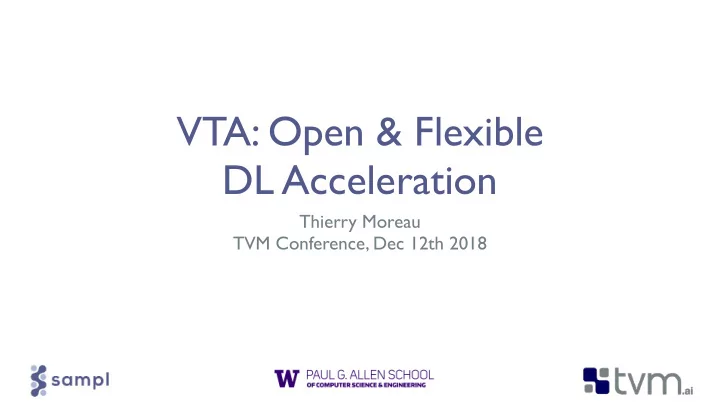

VTA: Open & Flexible DL Acceleration Thierry Moreau TVM Conference, Dec 12th 2018
TVM Stack High-Level Differentiable IR Tensor Expression IR LLVM CUDA Metal
TVM Stack High-Level Differentiable IR Tensor Expression IR LLVM CUDA Metal VTA: Open Hardware Accelerator
TVM Stack High-Level Differentiable IR Tensor Expression IR LLVM CUDA Metal VTA: Open Hardware Accelerator Edge FPGA
TVM Stack High-Level Differentiable IR Tensor Expression IR LLVM CUDA Metal VTA: Open Hardware Accelerator Edge FPGA Cloud FPGA
TVM Stack High-Level Differentiable IR Tensor Expression IR LLVM CUDA Metal VTA: Open Hardware Accelerator Edge FPGA Cloud FPGA ASIC
TVM Stack High-Level Differentiable IR Tensor Expression IR LLVM CUDA Metal VTA: Open Hardware Accelerator Edge FPGA Cloud FPGA ASIC
TVM Stack High-Level Differentiable IR Transparent End-to-End Deep Learning System Stack Tensor Expression IR LLVM CUDA Metal VTA: Open Hardware Accelerator Edge FPGA Cloud FPGA ASIC
TVM+VTA Stack Goals
TVM+VTA Stack Goals • Blue-print for a complete deep learning acceleration stack
TVM+VTA Stack Goals • Blue-print for a complete deep learning acceleration stack • Experimentation framework for cross- stack deep learning optimizations
TVM+VTA Stack Goals • Blue-print for a complete deep learning acceleration stack • Experimentation framework for cross- stack deep learning optimizations • Open-source community for industrial- strength deep learning acceleration
VTA Overview Extensible Hardware Architecture Programmability Across the Stack Facilitates HW-SW Co-Design
VTA Overview Extensible Hardware Architecture Programmability Across the Stack Facilitates HW-SW Co-Design
VTA: General DL Architecture
VTA: General DL Architecture Tensor Intrinsic 32 16 8 8 x 1 8 x 8 vs. 32
VTA: General DL Architecture Tensor Intrinsic Hardware Datatype 32 16 8 8 vs. <16 x i8> <32 x i4> x 1 8 x 8 vs. 32
VTA: General DL Architecture Tensor Intrinsic Hardware Datatype 32 16 8 8 vs. <16 x i8> <32 x i4> x 1 8 x 8 vs. 32 Memory Subsystem vs.
VTA: General DL Architecture Tensor Intrinsic Hardware Datatype 32 16 8 8 vs. <16 x i8> <32 x i4> x 1 8 x 8 vs. 32 Memory Subsystem Operation Support vs. vs. {ADD, MUL, SHL, MAX} {ADD, SHL, MAX}
VTA Hardware Architecture Philosophy: simple hardware, provide software-defined flexibility
VTA Hardware Architecture Philosophy: simple hardware, provide software-defined flexibility DRAM INSTRUCTION FETCH MODULE COMPUTE LOAD STORE CMD Q CMD Q CMD Q LD → CMP Q CMP → ST Q COMPUTE MODULE REGISTER MICRO-OP FILE BUFFER LOAD STORE MODULE MODULE Vector ALU CMP → LD Q ST → CMP Q Tensor Core INPUT BUFFER STORE BUFFER WEIGHT BUFFER
VTA Hardware Architecture DRAM INSTRUCTION FETCH MODULE COMPUTE LOAD STORE CMD Q CMD Q CMD Q LD → CMP Q CMP → ST Q COMPUTE MODULE REGISTER MICRO-OP FILE BUFFER LOAD STORE MODULE MODULE Vector ALU CMP → LD Q ST → CMP Q Tensor Core INPUT BUFFER STORE BUFFER WEIGHT BUFFER
Pipelining Tasks to Hide Memory Latency Monolithic Design LD LD EX EX LD LD EX EX LD LD EX EX LD LD EX EX ST ST LD: load EX: compute ST: store
Pipelining Tasks to Hide Memory Latency Monolithic Design LD EX LD EX LD EX LD EX ST Load Stage LD LD LD LD EX EX EX EX Execute Stage Store Stage ST LD: load EX: compute ST: store
Pipelining Tasks to Hide Memory Latency Monolithic Design LD EX LD EX LD EX LD EX ST Load Stage LD LD LD LD EX EX EX EX Execute Stage Store Stage ST latency savings LD: load EX: compute ST: store
Pipelining Tasks to Hide Memory Latency Monolithic Design LD EX LD EX LD EX LD EX ST Load Stage LD LD LD LD EX EX EX EX Execute Stage Store Stage ST latency savings low-level synchronization between tasks is explicitly managed by the software LD: load EX: compute ST: store
Two-Level ISA Overview Provides the right tradeoff between expressiveness and code compactness
Two-Level ISA Overview Provides the right tradeoff between expressiveness and code compactness • Use CISC instructions to perform multi-cycle tasks DENSE ALU LOAD STORE
Two-Level ISA Overview Provides the right tradeoff between expressiveness and code compactness • Use CISC instructions to perform multi-cycle tasks DENSE ALU LOAD STORE • Use RISC micro-ops to perform single-cycle tensor operations
Two-Level ISA Overview Provides the right tradeoff between expressiveness and code compactness • Use CISC instructions to perform multi-cycle tasks DENSE ALU LOAD STORE • Use RISC micro-ops to perform single-cycle tensor operations R0: R0 + GEMM(A8, W3)
Two-Level ISA Overview Provides the right tradeoff between expressiveness and code compactness • Use CISC instructions to perform multi-cycle tasks DENSE ALU LOAD STORE • Use RISC micro-ops to perform single-cycle tensor operations R0: R0 + GEMM(A8, W3) R2: MAX(R0, ZERO)
VTA RISC Micro-Kernels
VTA RISC Micro-Kernels multiple RISC instructions define a micro-kernel , which can be invoked by a CISC instruction
VTA RISC Micro-Kernels multiple RISC instructions define a micro-kernel , which can be invoked by a CISC instruction CONV2D: layout=NCHW, chan=128, kernel=(3,3), padding=(1,1), strides=(1,1)
VTA RISC Micro-Kernels multiple RISC instructions define a micro-kernel , which can be invoked by a CISC instruction CONV2D: layout=NCHW, chan=128, kernel=(3,3), padding=(1,1), strides=(1,1) CONV2D: layout=NCHW, chan=256, kernel=(1,1), padding=(0,0), strides=(2,2)
VTA RISC Micro-Kernels multiple RISC instructions define a micro-kernel , which can be invoked by a CISC instruction CONV2D: layout=NCHW, chan=128, kernel=(3,3), padding=(1,1), strides=(1,1) CONV2D: layout=NCHW, chan=256, kernel=(1,1), padding=(0,0), strides=(2,2) CONV2D_TRANSPOSE: ...
VTA RISC Micro-Kernels multiple RISC instructions define a micro-kernel , which can be invoked by a CISC instruction CONV2D: layout=NCHW, chan=128, kernel=(3,3), padding=(1,1), strides=(1,1) CONV2D: layout=NCHW, chan=256, kernel=(1,1), padding=(0,0), strides=(2,2) CONV2D_TRANSPOSE: ... GROUP_CONV2D: ...
VTA RISC Micro-Kernels micro-kernel programming gives us software-defined flexibility “cat” DCGAN ResNet50
How is VTA Programmed?
Recommend
More recommend